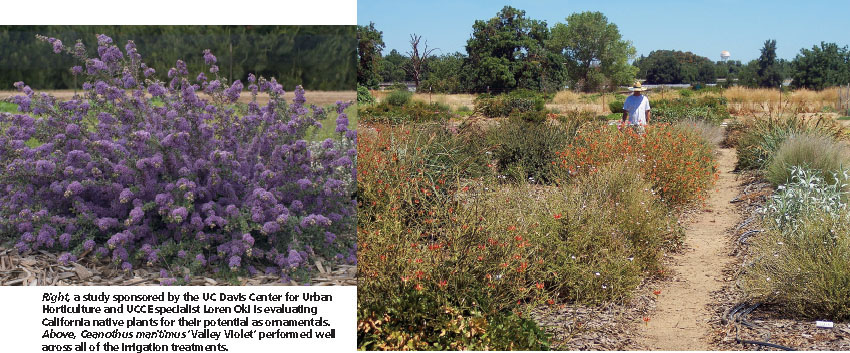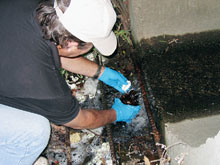All Issues
Regulators and researchers seek innovative water-quality solutions
Publication Information
California Agriculture 61(4):156-158.
Published October 01, 2007
PDF | Citation | Permissions
Full text
The quality of California's surface waters is regulated by two agencies: the U.S. Environmental Protection Agency (U.S. EPA), under the 1972 Clean Water Act, and the State Water Resources Control Board, which was established in 1967.
Under the Clean Water Act, the federal government took responsibility to regulate point-source pollution, while calling for state and local governments to regulate nonpoint-source pollution through regional plans. As a result, federal and state agencies have taken different approaches and set somewhat different water-quality standards, whether for pathogens, sediment, nutrients, pesticides or temperature.
The federal approach is based on how much of each pollutant is allowed in a given body of water (the total maximum daily load, or TMDL). In contrast, the state approach is based on controlling pollutants throughout a given watershed. California is divided into nine major watersheds, each with its own Regional Water Quality Control Board that sets its own standards. Not surprisingly, differences can arise among water-quality regulators. For example, both federal and state pathogen regulations use indicator bacteria such as Escherichia coli, however federal rules are based on E. coli levels, while most regional boards look at all coliforms ( see page 159 ).
— Editors
Left, a portable wetland is tested to remove fertilizer and pesticides from nursery runoff; right, UC Davis graduate student Mike Harris collects samples from sand filtration columns. Both technologies could help limit the spread of Phytophthora ramorum, which causes sudden oak death.
California's perennial water woes are now critical. Contributing factors include record drought conditions in parts of the state; increasing demands from a fast-growing population; deterioration of the San Francisco Bay-Delta infrastructure; an August 2007 federal court order to protect the endangered delta smelt by dramatically reducing water deliveries to agriculture and residences; and global climate change.
“We cannot wait until we have a Katrinalike disaster to attack this problem,” Governor Schwarzenegger said during a water summit with Senator Dianne Feinstein in August. In mid-September, the Governor proposed $9 billion in water-infrastructure spending; his Delta Vision Blue Ribbon Task Force will report its recommendations by January 2008.
Maintaining and upgrading the quality of surface waters is key to addressing the current crisis. To help protect streams and other surface waters, UC researchers are developing innovative, low-tech ways to control runoff pollution from farms, nurseries and cities. Runoff can carry pathogens, pesticides, nutrients and sediment, or change the temperature of waters where fish and other aquatic species spawn.
E. coli in farm runoff
Water quality often intersects with human health concerns. On Central Coast farms, for example, spinach was contaminated with a virulent strain of E. coli in fall 2006. These fecal bacteria can spread in water, and a leading theory holds that wild pigs may have tracked them from a nearby cattle ranch to the spinach field.
This spinach outbreak helped lead to the establishment in spring 2007 of the Center for Produce Safety, to be located at the UC Davis Western Institute for Food Safety and Security (WIFSS). The Center, which is funded primarily by the Produce Marketing Association and Taylor Farms of Salinas, will focus on facilitating information exchange, research and field training to reduce produce-related health risks.
“One issue is potential conflicts between food safety and water-quality practices,” says Rob Atwill, WIFSS director and Cooperative Extension specialist in veterinary medicine at UC Davis. “For example, while vegetation between fields and streams helps control erosion and control waterborne pathogens, bare soil borders around fields reveal footprints from disease-spreading animals.” To start finding common ground between these needs, WIFSS and UC Cooperative Extension (UCCE) sponsored the Management of Water Quality and Food Safety conference in April 2007 in San Luis Obispo.
Right, a study sponsored by the UC Davis Center for Urban Horticulture and UCCE specialist Loren Oki is evaluating California native plants for their potential as ornamentals. Above, Ceanothus maritimus 'Valley Violet' performed well across all of the irrigation treatments.
The spinach outbreak also led to creation of the Leafy Greens Marketing Agreement ( see page 177 ). Signed by handlers accounting for virtually all of California's leafy greens market, this July 2007 agreement certifies adherence to practices that reduce the risk of waterborne diseases. For example, growers avoid letting water stand in fields because it can attract animals, and they avoid the use of storm water for irrigation because it can have high levels of bacteria.
Sudden oak death in nursery runoff
Likewise, nurseries can have conflicts between plant health and water-quality practices. For example, collecting and reusing irrigation runoff could spread Phytophthora ramorum, the water mold that causes sudden oak death. While ultraviolet (UV) light kills P. ramorum, this is costly because it uses electricity and the runoff water has to be thoroughly precleaned.
To find an affordable treatment for P. ramorum in reclaimed nursery runoff, UC researchers are testing a two-step process adapted from other applications. The first step entails removing sediment, pesticides and many pathogens with portable subsurface wetlands. This part of the process is being tested by John Kabashima, UCCE Orange County director. Filled with gravel and planted with bulrushes, these artificial wetlands are similar to those used to treat sewage water nationwide.
“There are lots of benefits,” Kabashima says. “Portable wetlands are far more efficient, and because they cover far less land area, they have fewer wildlife or mosquito problems.” Moreover, their portability makes it easy to swap a clean unit for a dirty one.
The second step entails killing P. ramorum with slow sand filtration. This part of the process is being tested by Loren Oki, a UC Davis landscape horticulture specialist. His experimental setup comprises 6-foot vertical pipes full of sand, and water inoculated with a P. ramorum relative that infects pepper plants (P. capscici). The water also contains bacteria that eat water molds, and the sand gives these bacteria a surface to multiply on, while the slow filtration rate gives them enough time to eat all the water mold.
“It's a really old technology,” Oki says. “It's simpler and cheaper than UV irradiation.” Ultimately, he will use P. capscici to establish large colonies of bacteria that eat water mold in treatment pipes, which he will then test on stream water laden with P. ramorum.
Pesticides in urban runoff
UC researchers are also looking beyond agriculture to help cities qualify for their water pollution discharge permits, which are granted by the Regional Water Quality Control Boards. “First, cities hit the large businesses, such as sanitation districts, developers and nurseries,” says Darren Haver, UCCE waterquality advisor in Orange County. Now cities are addressing water pollution from nonpoint sources, which is more difficult both to measure and to control.
“At the agricultural-urban interface, there's lots of fingerpointing at farms for affecting water quality,” Haver says. But most farms there have been replaced by single-family homes, and while little is known about their impact on water, recent studies have revealed that urban stream sediments have high pesticide levels.
UCCE water-quality advisor Darren Haver is assessing three demonstration landscapes for the volume of runoff and pesticides. Left to right, typical high-, intermediate- and low-runoff homes.
To see if there is a direct link between residential runoff and surface-water pollution, Haver built three demonstration landscapes that span the spectrum of water use. Landscapes account for about half of residential water use, and much of this flows into gutters and concrete-lined storm channels that drain directly into streams and other surface waters.
A large-scale study is looking at runoff in eight Sacramento and Orange County suburban neighborhoods. UC Davis program coordinator Robert Mazalewski collects a sample for analysis.
Haver designed his demonstration landscapes both to assess pollutants in residential runoff and to test recommendations for reducing runoff. His landscapes simulate: (1) a typical high-runoff home with a big lawn, automatic sprinklers, and a concrete driveway and patio; (2) an intermediate-runoff home with a small, drought-tolerant lawn, and a permeable flagstone patio; and (3) a low-runoff home with native plants, drip irrigation, and an interlocking paver driveway and patio.
So far, the results suggest that pesticide levels are high in residential runoff. “We need to design our landscapes to keep water and pesticides on-site,” Haver says. When water soaks into the ground instead of running into the gutter, the pollutants in it also stay put. That gives the pesticides time to break down into nontoxic compounds. In addition, simply conserving water, which reduces runoff, would also do a lot to safeguard streams and other surface waters.
In addition, Haver and Oki are part of a large-scale study of residential runoff. This is the first study characterizing residential runoff and it's easy to see why — it took more than 6 months just to identify the study sites. There are four neighborhood sites in Sacramento and four in Orange County, and each has 100 to 400 single-family homes and no multifamily, commercial or agricultural land.
“The beauty of this study is that each site is the residential equivalent of a watershed, with the runoff ultimately flowing into a single storm drain that then feeds into a surface water,” Oki says. “This makes it possible to sample runoff from an entire neighborhood at a single point.”
As in the small-scale demonstration landscape study, this large-scale neighborhood study shows that residential runoff has high levels of pesticides. “There are spikes associated with the first storms of the season,” Oki says. These pesticides are pyrethroids and fipronil, which are used to control ants. Many homeowners have pest-control services that spray around the house exterior once a month, and the pesticide buildup washes away in the first rains.
By combining the results of these two studies, the researchers will determine whether outreach can reduce residential runoff. The outreach will be based on what works best in the demonstration landscapes, and will be delivered intensively to residents in half the neighborhood study sites. If this is effective, the “outreach” sites will have less runoff than the “nonoutreach” sites.
Native plant landscaping
To encourage more low-runoff landscaping in California, Oki and UC Davis graduate student Karrie Reid are identifying overlooked native plants that could appeal to mainstream gardeners. This work is part of an initiative for the commercial introduction of native plants sponsored by the UC Davis Center for Urban Horticulture, which was established in spring 2007. In contrast to native species, many nonnative garden plants need plenty of water during California's dry summers, as well as insecticides for pests that survive the mild winters. Initially, Oki and Reid are testing six native species that have performed spectacularly in the UC Davis Arboretum, including Apache plume (Fallugia paradoxa), a shrub with abundant 1-inch white flowers, and orange columbine (Aguilegia eximia), a showy perennial with 6-foot-tall flower spikes.
Finding effective ways of reducing residential runoff is increasingly important as the state's population continues to grow. “Do outreach and conservation really work?” Haver asks. “Or do we need someone to go around and give tickets?”








